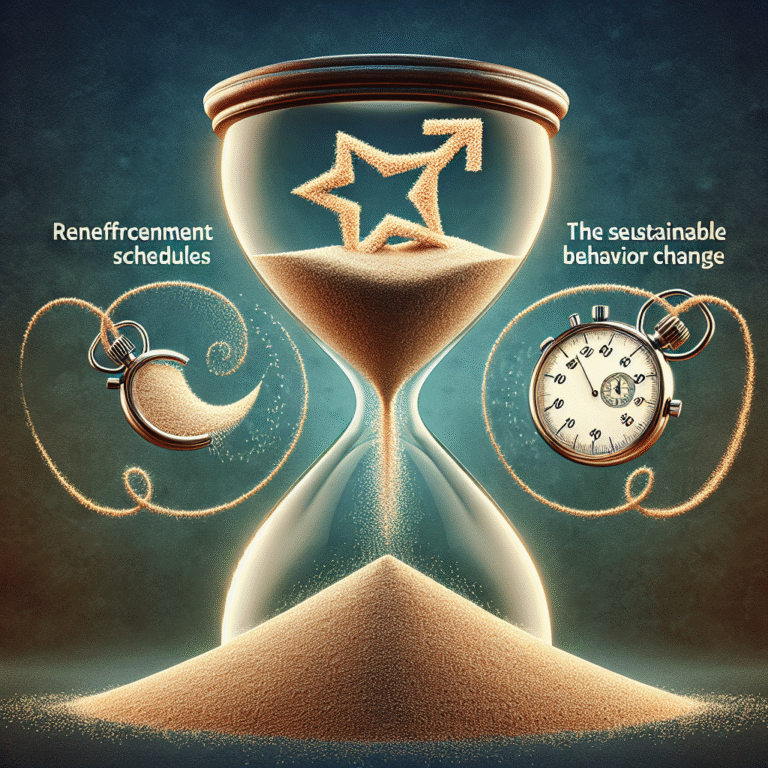
Introduction
In our journey through life, we constantly encounter a complex interplay of rewards and punishments that shape our behaviors. From the classroom to the corporate world, the nuances of reinforcement shape not only individual actions but also group dynamics and cultures. The phrase "From Punishment to Praise: Exploring Various Reinforcement Schedules" encapsulates a transformative approach towards learning and behavioral modification—a shift from fear-based systems to those rooted in encouragement and recognition.
This article aims to delve deeply into the mechanics of reinforcement schedules, illuminating their role in various contexts. We’ll explore the psychological theories behind reinforcement, investigate real-world case studies, and ultimately provide you with actionable insights that can elevate your approach to motivation—in education, the workplace, and beyond.
Understanding Reinforcement: A Quick Overview
Reinforcement, in psychological terms, refers to the practice of encouraging or establishing a pattern of behavior by offering rewards when the desired action is exhibited. Contrarily, punishment seeks to reduce undesirable behaviors through negative consequences. As we transition "from punishment to praise," it becomes essential to comprehend different reinforcement schedules that dictate how and when rewards are delivered.
Types of Reinforcement Schedules
- Continuous Reinforcement
- Partial Reinforcement
- Fixed Ratio
- Variable Ratio
- Fixed Interval
- Variable Interval
Each type of reinforcement schedule has unique implications for behavioral conditioning and outcomes. Understanding these can guide educators and leaders in crafting their approaches to motivation.
Continuous Reinforcement: The Foundation
Continuous reinforcement maintains a simple premise: every time a desired behavior occurs, a reward is provided. This approach can be effective in the early stages of learning a new behavior or skill, ensuring that individuals quickly associate the action with a reward.
Case Study: Classroom Application
In a classroom setting, a teacher may implement continuous reinforcement by praising students every time they complete their homework. Initially, this can lead to high motivation and quick mastery of tasks among students. Over time, however, the effectiveness may dwindle as students come to expect rewards for every action.
Table 1: Pros and Cons of Continuous Reinforcement
| Pros | Cons |
|---|---|
| Quick acquisition of behavior | Diminished return over time |
| Clear reinforcement of expectations | Dependence on rewards |
Partial Reinforcement: The Power of Intermittency
Partial reinforcement refers to providing rewards on a less than 100% basis, making the reinforcement unpredictable. This unpredictability can create more robust and lasting behavioral changes.
Fixed Ratio Schedule
In Fixed Ratio schedules, rewards are given after a specified number of responses. For instance, a salesperson may receive a bonus for every five sales made.
Case Study: Sales Implementation
A well-known company observed that using a Fixed Ratio schedule increased sales significantly compared to a continuous reinforcement approach. Salespeople, motivated by a clear target (five sales), often exceeded their quotas, illustrating the effectiveness of this strategy.
Graph 1: Sales Performance Before and After Implementing Fixed Ratio Schedule
| Salesperson | Sales Before | Sales After |
|---|---|---|
| A | 10 | 20 |
| B | 12 | 30 |
| C | 15 | 35 |
Variable Ratio Schedule
The Variable Ratio schedule reinforces behavior after an unpredictable number of responses. This model is often seen in gambling scenarios and is one of the most powerful motivators for sustaining behavior.
Case Study: Gambling Addiction
Research shows that individuals engaged in gambling continue to play because of the unpredictable nature of rewards. This can be a double-edged sword—while it promotes sustained engagement, it can also lead to addiction. This scenario emphasizes the importance of context when applying reinforcement schedules.
Fixed Interval Schedule
The Fixed Interval schedule rewards the first response after a predetermined time period, irrespective of how many responses occurred. Think of a paycheck received bi-weekly.
Case Study: Employee Performance
A company that first employed a Fixed Interval schedule noticed that employees worked harder as payday approached, illustrating the impact of a predictable reward on performance.
Variable Interval Schedule
In a Variable Interval schedule, rewards are given at unpredictable time intervals. This model maintains high levels of engagement and performance, as individuals are unsure of when the next reward will arrive.
Case Study: Social Media Engagement
Social media platforms thrive on Variable Interval schedules. Users continuously engage, hoping for likes, comments, or shares at irregular intervals. This unpredictability fosters a compelling environment for sustained user interaction.
Table 2: Reinforcement Schedules Overview
| Schedule Type | Behavioral Impact | Use Case |
|---|---|---|
| Continuous | Fast learning, short-lived | Early learning of tasks |
| Fixed Ratio | Motivation boosts | Sales commissions |
| Variable Ratio | High persistence | Gambling, video games |
| Fixed Interval | Performance spikes | Paychecks |
| Variable Interval | Long-term engagement | Social media platforms |
Transitioning from Punishment to Praise
The transition from punishment to praise requires a strategic approach rooted in understanding these reinforcement schedules. The effectiveness of praise as a reinforcement tactic cannot be overstated; it taps into human psychology’s core desire for recognition and validation.
The Case for Praise
- Enhanced Motivation: Positive reinforcement fosters a growth mindset and higher motivation levels among individuals.
- Fostering Competence: Employees and students who receive praise feel more competent, leading to improved performance.
- Creating Positive Environments: Encouragement results in cohesive teams and classrooms fostered by mutual respect.
Real-world Applications
Many organizations are shifting their culture from punitive measures to a praise-based system. Companies like Google and Zappos leverage a culture of recognition, leading to unparalleled employee satisfaction and retention.
Conclusions: From Punishment to Praise
As we have explored the many facets of reinforcement schedules, it becomes clear that navigating from punishment to praise holds immense potential for personal and professional growth. Embracing reinforcement in its many forms—whether it’s continuous for learning, variable for sustaining engagement, or transitioning from fear to appreciation—can lead to profound transformations.
Motivational Takeaway
Think of how you can apply these insights in your own environment. Are you focusing on what your team or students are doing right? Are you leveraging the power of praise effectively? Transitioning from a punitive mindset to one of encouragement fosters a positive atmosphere where individuals thrive.
FAQs
1. What is reinforcement in psychology?
Answer: Reinforcement in psychology refers to any stimulus that strengthens or increases the likelihood of a behavior. It can be positive (adding a reward) or negative (removing an unpleasant stimulus).
2. What are the types of reinforcement schedules?
Answer: The main types of reinforcement schedules are continuous reinforcement, partial reinforcement (fixed ratio, variable ratio, fixed interval, and variable interval).
3. How can I apply reinforcement schedules in the workplace?
Answer: You can apply reinforcement schedules by recognizing good work through praise, bonuses, or incentives on a schedule that best fits your team’s dynamics.
4. What are the dangers of relying solely on punishment?
Answer: Relying solely on punishment can create a toxic environment, leading to fear, resentment, and ultimately diminished performance.
5. How can I encourage positive behavior in children?
Answer: Encourage positive behavior in children by using praise and rewards consistently while understanding that different reinforcement schedules will be effective at different times.
With this thorough exploration of "From Punishment to Praise: Exploring Various Reinforcement Schedules," we invite you to implement these techniques and witness the transformative impact they hold.














